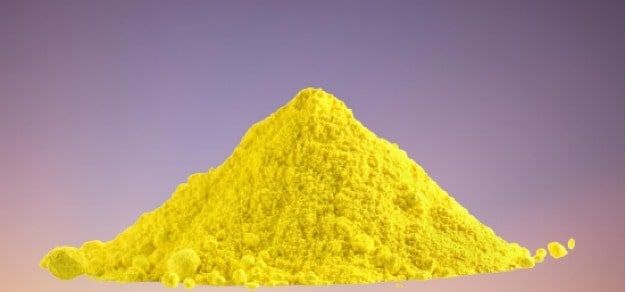Welcome To ChemAnalyst

Yellow phosphorus is used in a variety of chemical and industrial applications, notably in the production of phosphoric acid, phosphorus pentachloride, and phosphorus-based pesticides. It is also used in the manufacture of flame retardants, military-grade smoke munitions, and specialty alloys. Due to its high reactivity, yellow phosphorus serves as a key raw material in numerous organophosphorus compounds used in agriculture and pharmaceuticals.
I. Introduction
Yellow phosphorus (YP), also known as white phosphorus in some contexts, is a highly reactive allotrope of elemental phosphorus composed of tetrahedral P4 molecules. Produced via high-temperature reduction of phosphate rock in electric arc furnaces, YP is a key precursor to nearly all value-added phosphorus compounds used in global industry. In 2024, worldwide output of yellow phosphorus reached approximately 1.7 million metric tons and is forecast to grow at a compound annual rate of 3.5% through 2035, driven by rising demand from agriculture, flame retardants, electronics, and lithium-iron-phosphate (LFP) batteries. China currently dominates production with over 60% of global supply, leveraging abundant phosphate reserves and low-cost hydropower. However, supply remains vulnerable to energy rationing, and yellow phosphorus pricing remains volatile. Spot prices in 2024 fluctuated due to power shortages in Yunnan and Sichuan, key production hubs.
II. Industrial Applications by Sector
1. Fertilizers and Agrochemicals
Approximately 45% of yellow phosphorus is consumed in the production of thermal phosphoric acid (TPA), a high-purity acid used in specialty fertilizers, food-grade additives, and beverage formulations. TPA is a critical raw material for polyphosphates and ammonium phosphates used in precision agriculture.
Yellow phosphorus is also chlorinated to produce phosphorus trichloride (PCl3), a fundamental intermediate in pesticide and herbicide manufacturing. Glyphosate, the world’s most widely used herbicide, relies on PCl3-derived intermediates, accounting for nearly 12% of total yellow phosphorus demand. Other agrochemicals, such as chlorpyrifos and newer organophosphorus insecticides, also originate from this route.
2. Flame Retardants and Engineering Plastics
Yellow phosphorus is the precursor to red phosphorus, phosphorus esters, and polyphosphonates, which are utilized in flame-retardant systems. These compounds are essential in halogen-free flame retardants for electronics, electric vehicle enclosures, insulation foams, and textile coatings. Adoption of these phosphorus-based alternatives has accelerated due to regulatory pressure against brominated compounds. Between 2020 and 2024, demand for phosphorus flame retardants grew by over 20%, particularly in automotive connectors and lithium-ion battery housings.
3. Electronics and Semiconductors
Phosphoric and phosphorus acids derived from yellow phosphorus are critical etchants in semiconductor fabrication. They are used to clean silicon wafers, etch aluminium interconnects, and stabilize dielectric materials. Phosphine gas (PH3), produced from red phosphorus, is used in the epitaxial growth of indium phosphide (InP) semiconductors, which power high-speed photonic devices and next-generation 6G radio frequency chips. As chip geometries shrink to 5 nm and below, demand for ultra-pure phosphorus compounds has increased substantially, with the electronics segment growing by over 20% year-on-year in 2024.
4. Batteries and Energy Storage
The shift toward LFP batteries for electric vehicles and stationary energy storage is driving new demand for phosphorus. Battery-grade phosphoric acid, derived from yellow phosphorus in China, is reacted with iron oxide and lithium carbonate to produce LiFePO4 cathode materials. This trend has accelerated following China's push for safer and more cost-effective EV batteries. During the LFP boom of 2021–2022, yellow phosphorus prices surged threefold due to the sharp rise in cathode manufacturing activity. In response, new battery material ventures in Australia and North America are building integrated supply chains that include localized yellow phosphorus production for secure acid sourcing.
5. Metallurgy and Surface Treatments
PCl3-derived organophosphonates are used as corrosion inhibitors in water treatment systems, industrial boilers, and cooling towers. Phosphating solutions, based on TPA, are widely employed for steel surface treatment in automotive manufacturing to improve paint adhesion and corrosion resistance. Phosphate-based anodizing is also used in the aerospace sector for aluminium alloy protection.
6. Life Sciences, Military, and Specialty Applications
Food-grade phosphoric acid is used as a pH stabilizer in soft drinks and processed foods. In pharmaceuticals, ultrapure grades are essential for the synthesis of active pharmaceutical ingredients (APIs), where strict heavy metal limits apply. Yellow phosphorus also finds limited use in smoke-generation devices, incendiary applications, and specialty magnesium alloy castings for defence and aerospace components.
III. Market Demand and End-User Structure
The global demand structure for yellow phosphorus is diversified but dominated by agricultural and industrial uses:
Asia-Pacific is the largest production and consumption hub, accounting for nearly three-quarters of global yellow phosphorus output. However, North America and Europe remain key demand centres for high-purity grades used in electronics and pharmaceuticals.
IV. Product Grades and Specifications
Yellow phosphorus is sold in various grades depending on application requirements:
V. Substitutes and Limitations
Substitution of yellow phosphorus is technically possible in some sectors, but often results in performance compromises:
VI. Innovations and Circularity
Efforts to reduce environmental impact and diversify supply chains have spurred significant innovation:
VII. Conclusion
Yellow phosphorus is a foundational chemical for multiple modern technologies, from agriculture and food to batteries and electronics. As demand for electric vehicles, clean energy, and semiconductors continues to grow, so too does the strategic importance of yellow phosphorus. However, its production remains energy-intensive, and its supply chain is regionally concentrated and exposed to geopolitical and environmental risks.
The path forward lies in innovation—electrified, low-emission furnaces, closed-loop recycling systems, and safe, encapsulated product forms. As industries move toward sustainability and higher performance standards, yellow phosphorus will remain indispensable, powering essential sectors of the global economy well into the future.
We use cookies to deliver the best possible experience on our website. To learn more, visit our Privacy Policy. By continuing to use this site or by closing this box, you consent to our use of cookies. More info.
